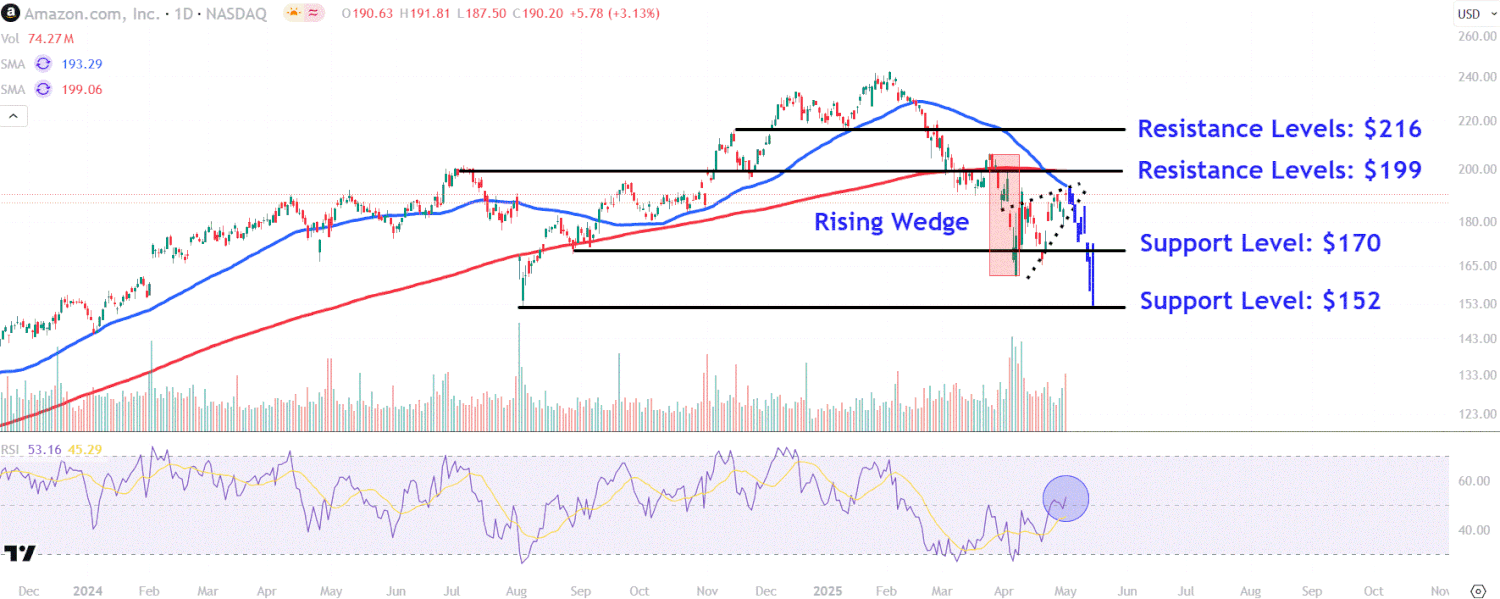When The Fed Will Finally Act

Jobs data beats expectations … Trump demands lower rates again … when Louis Navellier sees rates coming … weakening consumer data … a win on the China front?
This morning, the U.S. payrolls report came in stronger than expected.
The U.S. economy added 177,000 jobs in April, above the expectation of 133,000 jobs. This kept the overall unemployment rate at 4.2%.
Meanwhile, average hourly earnings climbed 0.2%. This was just below the 0.3% forecast. Similarly, the annual rate of 3.8% was below the 3.9% expectation.
The quick takeaway is that the economy remains steady and reasonably strong.
I write “reasonably” because we should factor in yesterday’s softer weekly jobless claims, which weren’t counted in today’s jobs numbers.
That report showed that initial unemployment claims posted an unexpected increase. First-time filings for unemployment insurance clocked in at 241,000, up 18,000 from the prior period and above the estimate of 225,000.
Now, some analysts are suggesting part of the increase might be attributable to spring break for public schools. But even so, continuing unemployment claims suggest growing weakness.
Here’s CNBC:
Continuing claims, which run a week behind and provide a broader view of layoff trends, rose to 1.92 million, up 83,000 to the highest level since Nov. 13, 2021.
Overall, even with those continuing claims numbers, we’re interpreting the last two days of jobs data as a win for the economy.
But for Fed watchers, is that good or bad?
This morning’s data don’t paint the picture of an economy in dire need of interest rate cuts.
And as we’ve highlighted in prior Digests, Federal Reserve Chairman Jerome Powell likely remains scarred by his characterization of inflation as “transitory” back in 2021. That inaccurate call opened the door to the worst inflation in four decades as well as merciless attacks on his judgement. My guess is that Powell is gun-shy about cutting rates too soon today, cracking open the door to another bout of inflation.
President Trump is not shy…
From the President on Truth Social this morning:
Just like I said, and we’re only in a TRANSITION STAGE, just getting started!!!
Consumers have been waiting for years to see pricing come down. NO INFLATION, THE FED SHOULD LOWER ITS RATE!!!
One must wonder whether this relentless pressure from Trump is ultimately counterproductive. His public demands for lower interest rates could actually harden Powell’s resolve, as the Fed Chair may be unwilling to appear influenced by the President or politically weak.
Given that the current data doesn’t demand an urgent rate cut, Powell might opt to hold off another month – if only to assert the Fed’s independence.
Optics aside, if legendary investor Louis Navellier gets his way, Powell and the Federal Reserve will be riding to the rescue next week
Let’s begin with Louis’ Flash Alert in Growth Investor yesterday:
There’s a growing sense of optimism because on Fox Business yesterday, Scott Bessent said the Fed should be cutting rates.
And that’s because the two-year Treasury yield is at its lowest level since last September. And it’s so far below the federal funds rate, there’s really three rate cuts the Fed should make.
And here’s this morning’s update after the jobs report:
Treasury yields rolled slightly in the wake of the payroll report. Yields are definitely at least 50 basis points below the fed funds rate.
If you look at the two-year Treasury note, they need to cut – they’re above market rates and they’re being restrictive.
For a visual on Louis’ point, below is the 2-year Treasury yield.
Unlike the 10-year Treasury yield, which has been volatile in 2025, the 2-year yield has been on a relatively smoother decline since January.
And as Louis highlighted, earlier this week, it notched its lowest level since last fall. But it has rolled slightly based on the jobs data.

Source: TradingView
Over the years, Louis has repeatedly said that the Fed doesn’t like to fight market rates. So, with the 2-year yield at 3.78% while the fed funds target rate sits at a range of 4.25% – 4.50%, it suggests lower rates ahead.
Back to Louis for how low and when – and some choice words about the Fed:
I’m predicting four rate cuts this year – largely due to the global collapse in interest rates in Europe…
We’re going to get a Fed rate cut in May. If we don’t, [the Fed members are] clinically insane – they’re not looking at the data. And the cause for them to cut will get louder and louder cause market rates will have collapsed.
We do have some people on the Fed that aren’t qualified, but they tend to move in consensus and they should follow market rates – that’s kind of a no-brainer, for lack of a better word.
I think the main message I have is that as soon as the Fed starts cutting, everybody realizes the Fed is going to be cutting, everything’s going to be fine.
While we await “fine,” let’s keep an eye on data from global outplacement firm Challenger, Gray & Christmas showing signs of weakness
Yesterday, Challenger, Gray & Christmas released its April jobs report.
First the good news: Planned job cuts dropped 62% to 105,441 last month.
As to the bad news, layoffs surged 63% compared to last year. Notably, April’s number came in at the highest reading for the month in five years.
And while the temptation is to blame this on DOGE and assume the cuts are limited to federal workers, that’s inaccurate. Here’s Andrew Challenger:
Though the Government cuts are front and center, we saw job cuts across sectors last month.
Generally, companies are citing the economy and new technology.
Employers are slow to hire and limiting hiring plans as they wait and see what will happen with trade, supply chain, and consumer spending.
The bottom line from the Challenger, Gray & Christmas report is that here in 2025, employers have announced 602,493 layoffs, the highest year-to-date total since 2020. This number is 87% higher than the 322,043 cuts announced this time last year.
Meanwhile, disappointing sales from fast-food giant McDonald’s also points toward a weakening consumer
McDonald’s is often seen as a key indicator of consumer spending and sentiment, particularly among lower-income customers. And its latest financial results suggest that these consumers are feeling uneasy. Or as McDonald’s CEO Chris Kempczinski put it:
Consumers today are grappling with uncertainty.
Yesterday, McDonald’s executives reported that U.S. same-store sales dropped 3.6% in Q1, marking the worst decline since Covid lockdowns kneecapped traffic. It was also the second consecutive quarter of same-store sales declines.
Back to Kempczinski:
In the U.S., overall [quick-service restaurant] industry traffic from the low-income consumer cohort was down nearly double digits versus the prior year quarter.
Unlike a few months ago, QSR traffic from middle-income consumers fell nearly as much, a clear indication that the economic pressure on traffic has broadened.
In recent days, we’ve heard similar commentary from executives at Chipotle, PepsiCo., and Starbucks.
From Chipotle CEO Scott Boatwright:
Saving money because of concerns around the economy was the overwhelming reason consumers were reducing the frequency of restaurant visits.
And here’s PepsiCo CFO Jamie Caulfield:
Relative to where we were three months ago, we probably aren’t feeling as good about the consumer now.
And Starbucks CEO Brian Niccol just referred to today’s economy as a “tough consumer environment.”
One final data point – though not related to fast food, it does reflect the financial health of lower-income Americans.
From Fortune:
Credit card data shows consumers are under increasing pressure, just as President Donald Trump’s tariffs are poised to significantly raise costs on everyday consumers.
Over 11% of Americans with accounts at the country’s largest banks only made the minimum payment on their credit card bills in the fourth quarter of 2024, a record since the Federal Reserve Bank of Philadelphia began tracking the number 12 years ago.
Bottom line: While we enjoy this recent market rally, and applaud the payroll data, let’s not overlook these real-world signs of weakness.
There’s a hint of good news on the trade war front
This morning, a spokesperson for China’s ministry of commerce said that Beijing was considering the possibility of tariff negotiations with the United States.
It was consistent with the need to “save face” that’s important to China, which we’ve highlighted in recent days.
From that spokesperson:
US officials have repeatedly expressed their willingness to negotiate with China on tariffs…
China’s position is consistent. If we fight, we will fight to the end; if we talk, the door is open…
If the US wants to talk, it should show its sincerity and be prepared to correct its wrong practices and cancel unilateral tariffs.
Meanwhile, The Wall Street Journal reports that China is now considering ways to address the Trump administration’s demands that China curb its role in fentanyl pouring into the U.S.
From the WSJ:
Chinese leader Xi Jinping’s security czar, Wang Xiaohong, in recent days has been inquiring about what the Trump team wants China to do when it comes to the chemical ingredients used to make fentanyl, the people said.
Chinese companies produce large quantities of the chemicals known as “precursors,” which are sold over the internet, flowing from China to criminal groups in Mexico and elsewhere that produce fentanyl and traffic it into the U.S…
The discussions remain fluid, the people cautioned, while adding that Beijing would like to see some softening of stance from President Trump on his trade offensive against China as well.
While not exactly a warm invitation to trade talks, it’s better than a cold refusal.
For now, we’ll take that as a win.
Before we sign off, let’s circle back to the Challenger, Gray & Christmas jobs report
Earlier, I highlighted a quote from Andrew Challenger in which he subtly echoed a theme I’ve been hammering on in recent weeks. Did you catch it?
Here’s the quote again:
Though the Government cuts are front and center, we saw job cuts across sectors last month.
Generally, companies are citing the economy and new technology.
Employers are slow to hire and limiting hiring plans as they wait and see what will happen with trade, supply chain, and consumer spending.
Rephrasing, one of the two reasons given by management for jobs cuts across a range of sectors is…
“New technology.”
My guess is that’s a reference to some version of robotics and the next iteration of AI advancements.
On that note, if you missed last night’s event with Luke Lango about investing in robotics and humanoids today, you can catch a free replay here.
Here’s Luke:
Steel mills, chip fabs, and assembly lines buzzing with “Made in the U.S.A.” labels: The president has promised all of this in a bid to get America’s factories booming.
There’s just one teensy problem…
You can’t rebuild American manufacturing without robots…
That’s why the next great fortune won’t come from chatbots or cloud software. It will come from physical AI—the robotic arms, vision sensors, and autonomous movers that transform concrete slabs into fully automated factories.
Last night, Luke dove into all these details and more, also highlighting his favorite robotics plays today. He also explains why he’s betting on an event next week that will pop the $7 trillion “cash bubble” parked in money-market funds today. Luke believes this will unleash a massive rotation back into stocks.
Here’s that link again to the free replay.
We’ll keep you updated on all these stories here in the Digest.
Have a good evening,
Jeff Remsburg


























